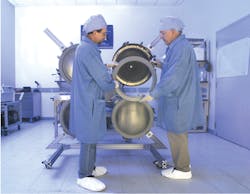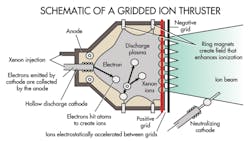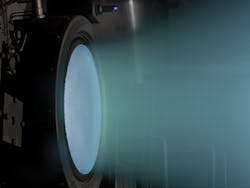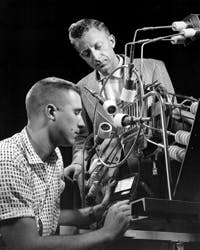NASA ion thruster sets endurance record
NASA’s Evolutionary Xenon Test thruster (NEXT) recently finished operating for over 48,000 hr, or 5.5 years, in a vacuum chamber at the Glenn Research Center in Cleveland. It set a record as the longest test of any space-propulsion system. Over that time, the engine, which was partly built by Aerojet Rocketdyne, Calif., consumed 1,918 lb of xenon while generating thrust that would take a conventional chemical rocket engine 22,000 lb of propellant to create. Engineers at Glenn Research Center designed and constructed the engine’s core ionization chamber. NEXT constantly put out 236 mN of thrust, enough to accelerate a 1,000-kg satellite in space at 0.000236 m/sec2, which works out to an additional 20.4 m/sec added every day.
The thruster works by using electricity to ionize xenon, then accelerating those ions out the back of the engine using electric fields and thereby generating thrust. Ion thrusters will not work in Earth’s atmosphere due to the presence of too many ions, so they can only be used in the vacuum of space. This limits them to station keeping and long, unmanned, intrasolar-system travel, tasks that need not be done in a hurry. But ion thrusters are more efficient than conventional chemical rockets, getting 10 to 12 times more thrust out of each pound of propellant. Ion thrusters are usually reserved for spacecraft with solar cells, which generate electricity without expensive or heavy fuel.
The main goal of the NEXT program was extending the service life of ion thrusters. The devices create high-energy ions which degrade and damage metal components by sputtering away the metal. The effect is pronounced in two-electrode or dual-grid thrusters, such as NEXT. The grids are oppositely charged and xenon ions accelerate out the rear, passing through a pair of holes precision-drilled in each grid. The holes act as optics to electrically focus the beam of ions for maximum thrust. Over time, ions eat away at the grids and the hollow cathode that creates the ions, lowering efficiency and eventually leading to failure. Advancements in computer modeling, hollow-cathode technology, and improved optics let NASA significantly extend the life of NEXT, as shown by the recent multiyear test.
Future development will concentrate on getting thrusters to operate at higher power and speed levels, and for longer durations. Engineers also want to make the thrusters lighter, more compact, and more reliable by using carbon-based ion optics and electron cyclotron resonance which uses microwaves to generate an ion-creating plasma.
Resources: Aerojet Rocketdyne, NASA Glenn Research Center




